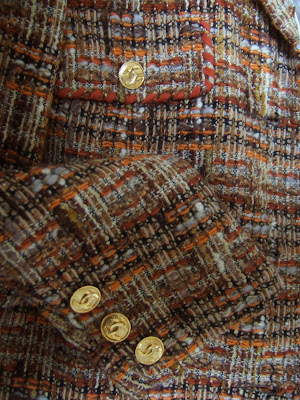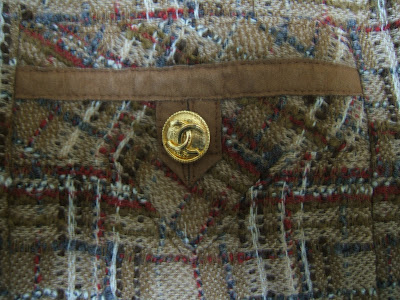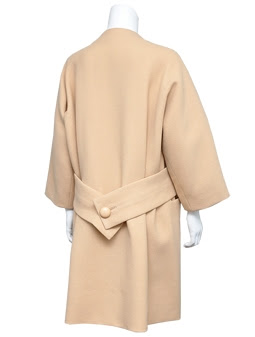 a Linton tweed suit by Auckie Sanft of Montreal features a band of the diagonal rib material used as a welt or piping, an innovation likely adapted from an original Chanel using the identical fabric
a Linton tweed suit by Auckie Sanft of Montreal features a band of the diagonal rib material used as a welt or piping, an innovation likely adapted from an original Chanel using the identical fabric  this was sold at the prestigious St. Regis Room (also known as "the Room") of the flagship Simpson's store (now owned by the Hudson's Bay Company) on Queen Street in Toronto
this was sold at the prestigious St. Regis Room (also known as "the Room") of the flagship Simpson's store (now owned by the Hudson's Bay Company) on Queen Street in Toronto labels of the above suit
labels of the above suit
 note the gilt buttons with double CC Chanel buttons, and the skillful way the material has been manipulated to make an excellent edging
note the gilt buttons with double CC Chanel buttons, and the skillful way the material has been manipulated to make an excellent edgingIn three decades of experience of working with and studying vintage clothing, I’ve seen a lot. The spectrum ranges from pristine Paris couture to decades old Levi’s denim, to rare and valuable leather motorcycle gang or WWII aviator jackets with cartoon like leather appliqued motifs. For the most part, the search, be it at prestige auctions, estate sales, antique shows, Salvation Army outlets, or in curbside garbage, is like finding a needle in a haystack. In spite of limited success and discovery I consider it a pleasurable treasure hunt for grownups.
When one is confronted with heaps, stalls, and racks of vintage clothing, the eye learns to quickly scan for colour, quality, rarity and the unique. Go looking for a specific item and it will never show up, but the unexpected often does. In this search anything is possible…like the colourful leather Wonder Woman boots. Where did they come from, and how were they used? Were they part of a very elaborate Hallowe’en costume, or were they an ironic accent in a circa 1970 hippy outfit?
Of course one is excited to find vintage Chanel, Hermes and Vuitton, but after looking at thousands and thousands of items, I’ve come to conclusion that there are plenty of other brands, or even anonymous pieces, that are as good as the most prestigious brands. For example, the leather goods of the American firm Ghurka or even pre-Chinese manufactured Coach sometimes surpass Hermes in quality, design, and durability, and are 1/10th the price. Some “Vuitton” items are lined with leather rather than fabric, and are better made than the originals.
One of the interesting vintage products that I see from time to time, are the fine clothes of Montreal designer Auckie Sanft. I am not sure exactly what years they were in production, but stylistically, the pieces I’ve encountered would date from 1960 to 1975. Their signature look was an interpretation of the classic Chanel tweed suit, and they did some very carefully selected copies of iconic French designer dresses, such as Yves Saint-Laurent pop art dresses from the period. But it is these Canadian “Chanel” suits and jackets that are remarkable. They are beautifully made and styled. They have gilt buttons with the famous Chanel interlocking double C logo. The tweeds are superb Linton (linings have the Linton tweed label), identical to those Coco Chanel herself selected. These tweeds are light, soft, and show an adept use of colour and texture; they are as visually satisfying as artisanal tapestry.
When one is confronted with heaps, stalls, and racks of vintage clothing, the eye learns to quickly scan for colour, quality, rarity and the unique. Go looking for a specific item and it will never show up, but the unexpected often does. In this search anything is possible…like the colourful leather Wonder Woman boots. Where did they come from, and how were they used? Were they part of a very elaborate Hallowe’en costume, or were they an ironic accent in a circa 1970 hippy outfit?
Of course one is excited to find vintage Chanel, Hermes and Vuitton, but after looking at thousands and thousands of items, I’ve come to conclusion that there are plenty of other brands, or even anonymous pieces, that are as good as the most prestigious brands. For example, the leather goods of the American firm Ghurka or even pre-Chinese manufactured Coach sometimes surpass Hermes in quality, design, and durability, and are 1/10th the price. Some “Vuitton” items are lined with leather rather than fabric, and are better made than the originals.
One of the interesting vintage products that I see from time to time, are the fine clothes of Montreal designer Auckie Sanft. I am not sure exactly what years they were in production, but stylistically, the pieces I’ve encountered would date from 1960 to 1975. Their signature look was an interpretation of the classic Chanel tweed suit, and they did some very carefully selected copies of iconic French designer dresses, such as Yves Saint-Laurent pop art dresses from the period. But it is these Canadian “Chanel” suits and jackets that are remarkable. They are beautifully made and styled. They have gilt buttons with the famous Chanel interlocking double C logo. The tweeds are superb Linton (linings have the Linton tweed label), identical to those Coco Chanel herself selected. These tweeds are light, soft, and show an adept use of colour and texture; they are as visually satisfying as artisanal tapestry.
 this late 1960s Auckie Sanft Linton tweed suit has an orange lining, and russet and tangerine yarns in the fabric
this late 1960s Auckie Sanft Linton tweed suit has an orange lining, and russet and tangerine yarns in the fabric note the wear around the buttonhole, through the lining to the canvas inner construction; the tweed exterior is entirely unworn and looks like new
note the wear around the buttonhole, through the lining to the canvas inner construction; the tweed exterior is entirely unworn and looks like newAuckie Sanft pieces were sold at the Simpson’s St. Regis Room (ironically they sold original Chanel later in the 1980s and early 1990s), Eaton’s, Holt Renfrew, Creed’s, and the WASP-y Ada Mackenzie shop in trendy Yorkville.
How does an Auckie Sanft suit differ from a vintage Chanel original? The linings were not silk, the jacket hems are not weighted with gilt chains, and they didn’t come with matching blouses. An original Chanel jacket usually uses 3 varying sizes of buttons; on a Sanft jacket the buttons are all of one size. They also lack the triangle inset of material under the arm where the sleeve is affixed to the body of the jacket (this gave ease of movement). Other than this they look, and can absolutely pass for Chanel. I’ve found Sanft Linton tweed jackets in which the linings are worn to shreds, but the tweed itself shows no wear whatsoever. Like Harris tweed and other fine fabrics, it is incredibly durable.
If ever you come across an Auckie Sanft “Chanel,” grab it. It looks as good as a new $10,000. Chanel jacket and it will be under $150.00, sometimes much less.
I’m not sure if there was a sort of licensing agreement with Chanel or use of a toile or pattern when Auckie Sanft produced their pieces and put gilt CC buttons, but whatever their arrangements were, if any, they are an excellent example of how a coveted example of Paris couture fashion was translated for the North American, specifically Canadian market. For this reason, I’m sure there are examples of Sanft “Chanels” in the textile and fashion collections of Canadian museums.
 the Canadian made garment with union tag is now as rare as a horse and buggy; even some of the most prestigious manufacturers, such as Brooks Brothers and Coach, are now manufacturing in China
the Canadian made garment with union tag is now as rare as a horse and buggy; even some of the most prestigious manufacturers, such as Brooks Brothers and Coach, are now manufacturing in China
How does an Auckie Sanft suit differ from a vintage Chanel original? The linings were not silk, the jacket hems are not weighted with gilt chains, and they didn’t come with matching blouses. An original Chanel jacket usually uses 3 varying sizes of buttons; on a Sanft jacket the buttons are all of one size. They also lack the triangle inset of material under the arm where the sleeve is affixed to the body of the jacket (this gave ease of movement). Other than this they look, and can absolutely pass for Chanel. I’ve found Sanft Linton tweed jackets in which the linings are worn to shreds, but the tweed itself shows no wear whatsoever. Like Harris tweed and other fine fabrics, it is incredibly durable.
If ever you come across an Auckie Sanft “Chanel,” grab it. It looks as good as a new $10,000. Chanel jacket and it will be under $150.00, sometimes much less.
I’m not sure if there was a sort of licensing agreement with Chanel or use of a toile or pattern when Auckie Sanft produced their pieces and put gilt CC buttons, but whatever their arrangements were, if any, they are an excellent example of how a coveted example of Paris couture fashion was translated for the North American, specifically Canadian market. For this reason, I’m sure there are examples of Sanft “Chanels” in the textile and fashion collections of Canadian museums.
 the Canadian made garment with union tag is now as rare as a horse and buggy; even some of the most prestigious manufacturers, such as Brooks Brothers and Coach, are now manufacturing in China
the Canadian made garment with union tag is now as rare as a horse and buggy; even some of the most prestigious manufacturers, such as Brooks Brothers and Coach, are now manufacturing in China






